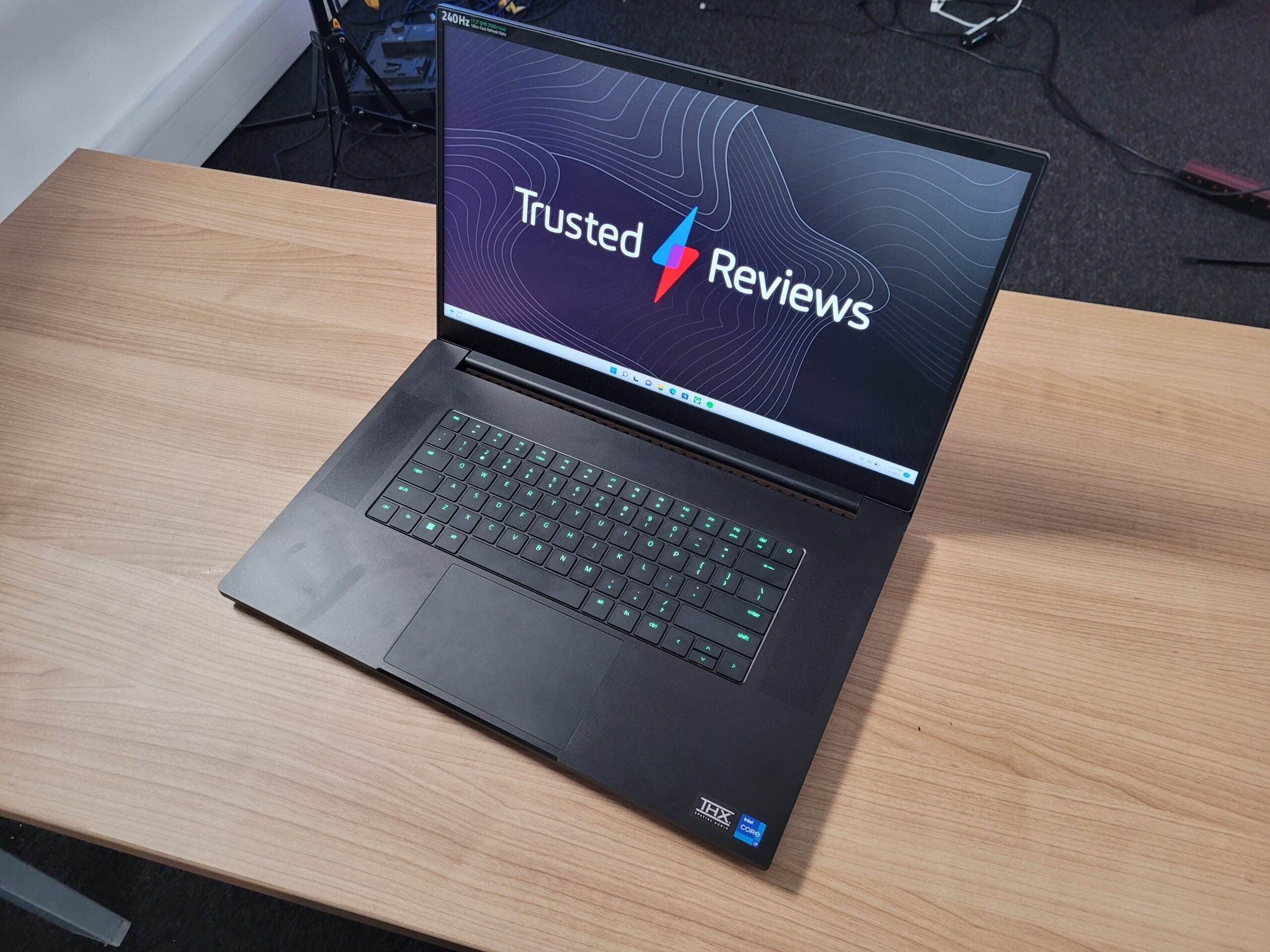The Razer Blade 17 (2022) is a monstrously powerful gaming laptop with a wonderfully high refresh rate that should please even the eSports crowd. But an absurdly expensive price will likely put off most, especially when it’s possible to find similar specs for less with rival systems.
Pros
- Ultimate gaming laptop performance
- Classy design
- Huge screen improves immersion
- Can double up as a laptop for content creation
Cons
- Absurdly expensive
- Abysmal battery life
- Too heavy for on-the-go gaming
-
Cutting-edge componentsThe Razer Blade 17 can be configured with an Intel Alder Lake chip and Nvidia RTX 3080 Ti, both of which are the most powerful specs currently available in a laptop -
Huge 17-inch displayCompared to most other laptops, the screen here is massive, creating a more immersive experience for playing games -
Up to 360Hz refresh rateRazer offers a wide range of refresh rates as high as 360Hz. This ensures that fast motion is presented clearly, delivering an advantage in multiplayer shooters where accuracy is key
Introduction
The Razer Blade 17 2022 is a monster gaming laptop. Not only can it be configured with the world’s fastest mobile GPU in the Nvidia RTX 3080 Ti, but the new 2022 edition has also been upgraded with Intel’s 12th Generation (Alder Lake) processor.
Such a combination enables Razer to offer one of the fastest gaming performances you’ll likely find in a gaming portable, capable of even embarrassing desktop gaming rigs in comparison.
The classic ink-black Razer design returns, too, while the 17-inch panel delivers a blockbuster experience for all of your PC games. Such a spec list is as good as it gets for a gaming laptop, but is the Razer Blade 17 2022 truly the full package?
Design
- Extremely heavy, with sturdy build
- Can look grimy with fingerprint marks
- Keyboard feels too shallow
Razer has stuck with more or less the same design for quite some time now, and for good reason. The jet black, anodized aluminium finish looks professional, while the luminous green logo on the lid adds enough gaming personality to avoid it looking like a bland office-based laptop.
But while the black finish looks smart straight out of the box, it does end up looking grimy after extended use; my fingerprints can already be seen smudged all over the lid and chassis. A quick wipe with a cloth will clean it up quickly, but it’s still an annoying faff and an issue that has been plaguing Razer laptops for several years now.
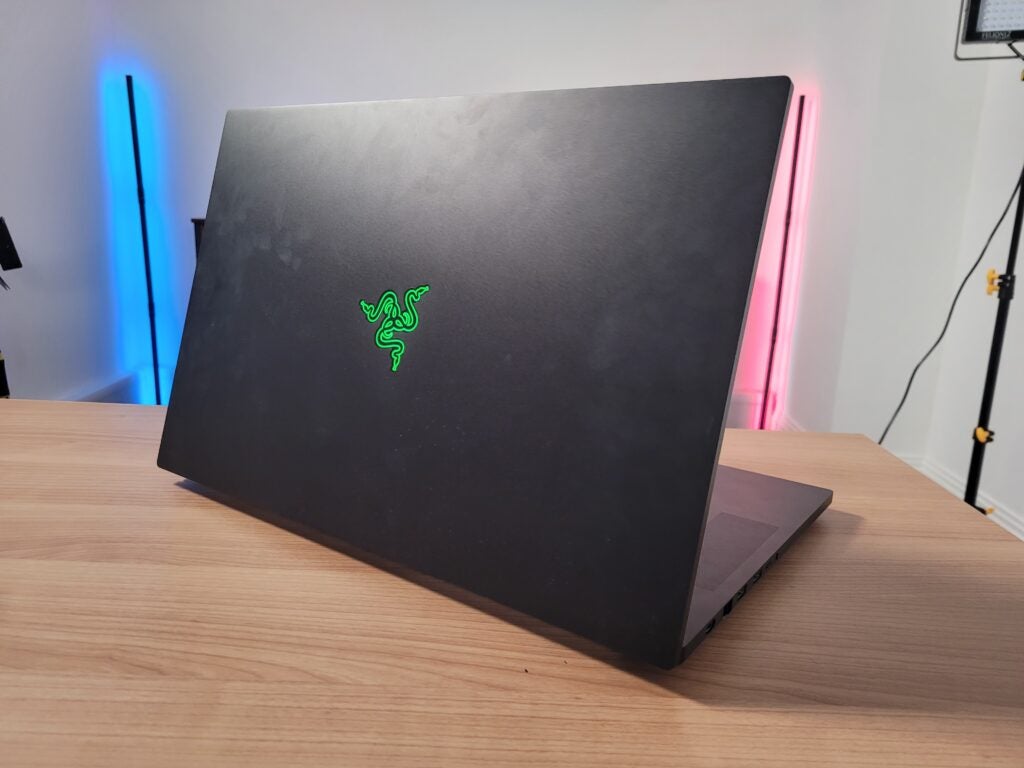
Many gaming laptops are accused of having bulky builds, but not the Razer Blade 17 2022; it measures in at just 19.9mm thick, which is astounding for a 17-inch laptop. That doesn’t translate to a lightweight design, though, with the Razer Blade 17 weighing a back-breaking 2.75kg.
Since I consider even 2kg laptops to be too heavy for frequent commutes, the Razer Blade 17 is so heavy that you’ll only really be able to use it as a desktop replacement at home. However, that’s the compromise you’ll have to make when purchasing a 17-inch gaming laptop with these kind of specs.
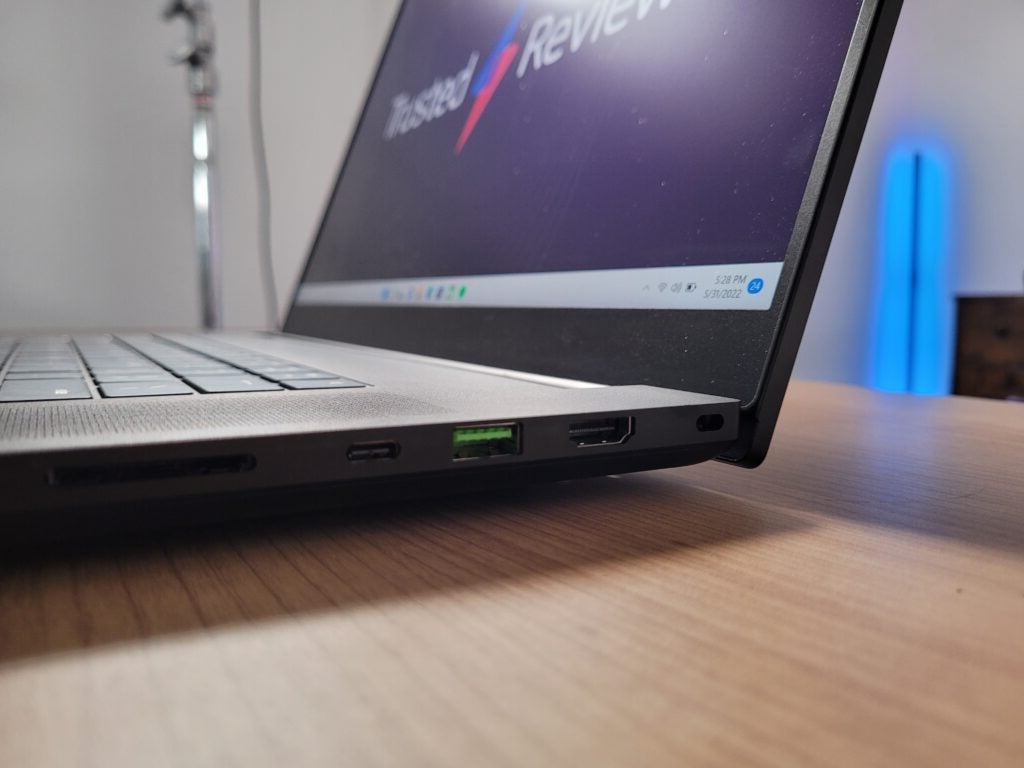
The port selection is top class with Thunderbolt 4, USB-A, Ethernet and HDMI all included. There’s also connectivity from Wi-Fi 6E and Bluetooth 5.2.
The keyboard has vibrant per-key Chroma backlighting, ensuring that this laptop’s gaming credentials are abundantly clear. It looks fantastic and can be personalised with the easy-to-use Razer Synapse software, which is among the best in the business.
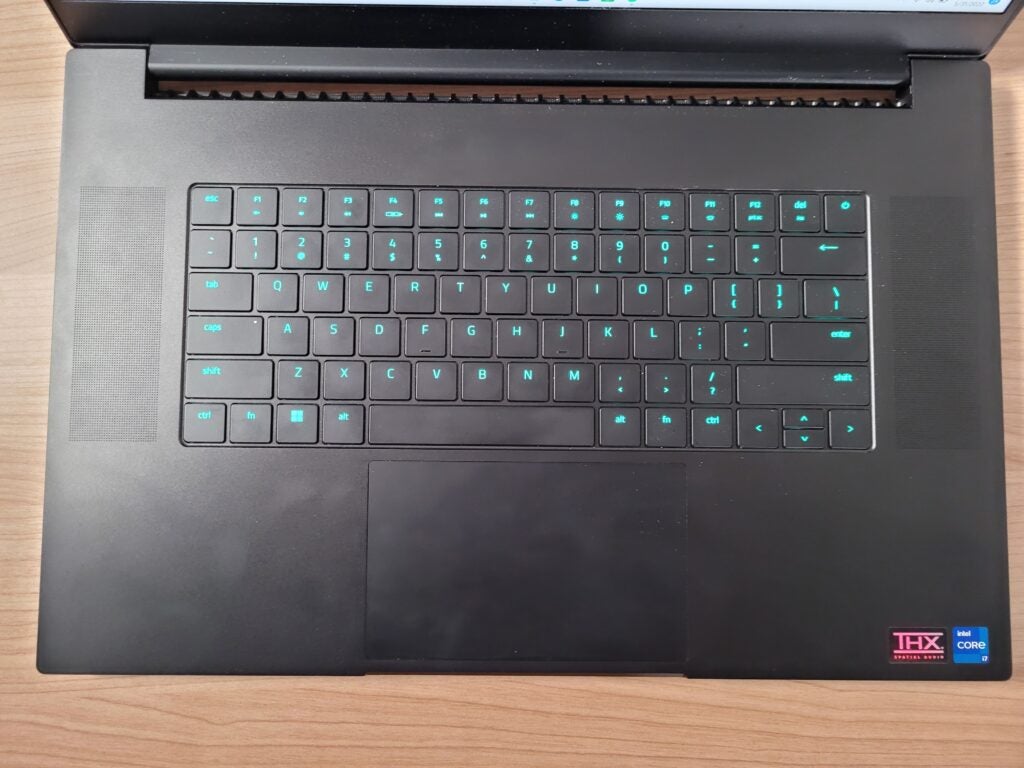
Personally, I’m not a huge fan of the keyboard itself. Key presses feel shallow, lacking the more crunchy feel of rival systems such as the Gigabyte AORUS 17G (2021). The keyboard also feels bizarrely cramped, despite the laptop’s wide 17-inch frame. This is because Razer has slapped a speaker on either side of the keyboard, resulting in booming, detailed audio that makes games sound excellent if you decide to play without a gaming headset.
The trackpad is suitably large, with a glass finish that feels pleasingly smooth. It’s responsive enough for day-to-day tasks, but you’ll still want a dedicated gaming mouse to play games.
Display
- Huge 17-inch screen
- Refresh rate options up to 360Hz
- Professional-grade colour accuracy
Razer offers a wide range of spec options for its 17-inch screen. You can opt for Full HD, QHD or 4K configurations, while the refresh rate scales between 144Hz and 360Hz. Sadly, there’s no OLED option in 2022, but that isn’t exactly common in the gaming laptop space.
When playing games on the Razer Blade 17, I was super-impressed by the picture quality. On-screen colours look bright and vivid, with our colorimter recording an above-average brightness and a respectable 1140:1 contrast.

When watching the Thor: Love and Thunder trailer on the laptop, I was impressed at how it dealt with the abundance of striking colours yet was still capable of delivering a realistic presentation with no obvious oversaturation.
Our colorimeter also showed the Razer to offer fantastic colour coverage, achieving 99% in sRGB, 83% in sRGB and 97.50% in DCI-P3. These are professional-grade results, which means it can accurately present the likes of digital art, photos and videos. As a result, the Razer Blade 17 is a great choice for content creators and is a worthy alternative to Apple’s MacBook Pro, too.
Performance
- Ultimate gaming laptop performance
- Laptop can become hot under strain
- Impressively quick SSD speeds
The Razer Blade 17 has a wealth of spec configuration options, ranging from the Nvidia RTX 3060 GPU all the way up to the all-powerful Nvidia RTX 3080 Ti. It also comes flaunting the cutting-edge Intel Core 12th Generation (Alder Lake) processor, accompanied with either 16GB or 32GB of DDR5 RAM. You couldn’t really ask for more from a gaming laptop.
Razer sent over a review model with a Nvidia RTX 3080 Ti GPU, Intel Core i7-12800H CPU and 32GB of RAM – that’s almost the very best configuration available, with only an i9 Intel chip capable of upgrading it further.
Benchmark tests proved that this is the most powerful gaming laptop I’ve ever tested. With a multi-core Geekbench 5 score of 13,144 and a 3DMark Time Spy of 12,671, it outscored both the ROG Zephyrus M16 2022 and Alienware x17 R2 laptops.
| Razer Blade 17 2022 | ROG Zephyrus M16 2022 | Alienware x17 R2 | |
| CPU | Intel Core i7-12800H | Intel Core i9-12900H | Intel Core i7-12700H |
| Geekbench 5 single/multi-core | 1804 / 13,144 | 1822 / 11,591 | 1686 / 12,040 |
| PCMark 10 | 7388 | 7960 | 7856 |
| GPU | RTX 3080 Ti | RTX 3070 Ti | RTX 3080 Ti |
| 3DMark Time Spy | 12,671 | 9291 | 12,486 |
But what kind of performance does this translate to for gaming? For Horizon Zero Dawn in Quad HD and Full HD, it achieved an average performance of 99fps and 119fps. And for Borderlands 3, it delivered 80fps and 104fps at the same resolutions.
I also played Dirt Rally to see how this laptop performs with older titles. It scored a mighty impressive 139fps in Quad HD, and 187fps in Full HD, with high enough results to make the most out of its screen’s blazing-fast refresh rate.
Those are some of the best results I’ve ever seen on a gaming laptop, although they only marginally beat the Alienware x17 R2 (2022), which offers the same specs. Nevertheless, the Razer Blade 17 is one of the absolute best gaming laptop options if you crave the ultimate performance. That may not be too useful in single-player games, but will be a boon for competitive gaming online.
That high-speed Intel chip makes a significant difference to workloads beyond gaming. The Razer Blade 17 boots up in an instant and it can cope with multiple apps, browser windows and software running in the background. In fact, this laptop is a great option for video editing and 3D animation, especially since you can switch over to Nvidia’s Studio Driver to optimise the GPU performance for content creation.
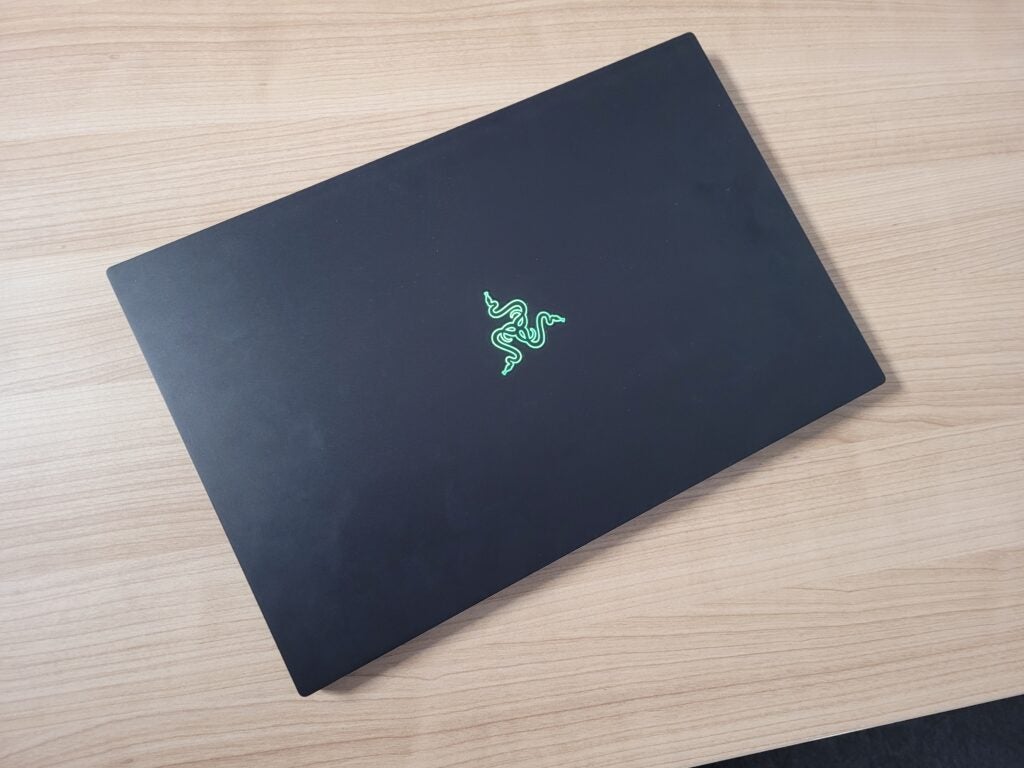
But with great power comes great heat. The top of the deck, between the keyboard and screen, can become so hot that it will scorch your fingers. Fortunately, your hand shouldn’t naturally rest in these areas, but it’s a sign that performance throttling could be an issue. When under stress, the fans can become a little loud, too, although you can drown out this noise by whacking up the volume or donning a gaming headset.
The Intel Alder Lake chip isn’t only fast, but also offers support for PCIe 4.0 to enable compatibility with next-gen SSDs. Razer has clearly taken advantage of this, as we recorded SSD read and write speeds of 6929MB/s and 4902MB/s. These are twice as high as the usual speeds of high-performance gaming laptops, which means loading screens will flash by even quicker than on a PS5 or Xbox Series X.
Battery Life
- Poor battery life
- Best to keep it plugged in
The Razer Blade 17 may be a juggernaut when it comes to performance, but the consequence of this is dismal battery life.
After turning the brightness down to 150 nits after activating a PCMark 10 benchmark that simulates day-to-day office work, the Razer Blade 17 lasted only 2hrs 55mins. That’s one of the worst results I’ve seen from a gaming laptop, although the majority will only eke out an additional two or three hours.
It’s also hardly a surprise given the high-end components that sit inside the Razer Blade 17. And since it’s too heavy to be lugging around everywhere, it’s best to keep this laptop plugged in at all times anyway. The gaming performance will take a significant hit if you try to play on the battery instead.
Latest deals
Should you buy it?
You want the ultimate gaming performance from a laptop With an Intel Alder Lake chip and RTX 3080 Ti GPU, you’ll struggle to find a more powerful laptop than the Razer Blade 17. With the highest configuration you can play any PC game at any resolution, while also being able to get an eSports-grade frame rate when playing in Full HD.
You want a portable gaming laptop The Razer Blade 17 is so heavy that you can essentially rule out the possibility of on-the-go gaming. That huge 17-inch screen also makes it difficult to fit inside a bag, while the poor battery life limits its use away from the mains. All things considered, it’s best to keep the laptop rooted to your desk and plugged into the mains.
Final Thoughts
The Razer Blade 17 is an impressive gaming laptop. It’s available in a wide range of configurations, with the GPU options climbing all the way up to the ultra-powerful RTX 3080 Ti – I’ve never seen a better gaming performance from a portable.
However, this laptop is also absurdly expensive, with the high-end configuration costing more than £4000. At such a cost, it’s worth considering whether you’re better off with a desktop PC, especially since the Blade 17 is too heavy for on-the-go gaming. The Alienware x17 R2 (2022) is a great alternative, offering similar specs and a lower price; but if you’re committed to the Razer brand, the Blade 17 remains a terrific option.
How we test
Every gaming laptop we review goes through a series of uniform checks designed to gauge key things including build quality, performance, screen quality and battery life.
These include formal synthetic benchmarks and scripted tests, plus a series of real world checks, such as how well it runs when running a AAA game.
We used as our main laptop for at least a week.
Tested the performance via both benchmark tests and real-world use.
We tested the screen with a colorimeter and real-world use.
We tested the battery with a benchmark test and real-world use.
FAQs
The cheapest Razer Blade 17 is available for £2799.99, but you’ll need to spend £4499.99 in order to purchase the most expensive configuration.
Yes, Razer is one of the most respected brands when it comes to PC gaming. It’s built a great reputation thanks to its stylish designs, but Razer Blade laptops do generally cost more than portables from other companies.
Trusted Reviews test data
Borderlands 3 frame rate (Quad HD)
Horizon Zero Dawn frame rate (Quad HD)
Horizon Zero Dawn frame rate (Full HD)
Dirt Rally (Quad HD)
Dirt Rally (Full HD)
Borderlands 3 frame rate (Full HD)
PCMark Battery (office)
Brightness
CrystalMarkDisk Write Speed
CrystalDiskMark Read speed
3DMark Time Spy
Geekbench 5 multi core
Geekbench 5 single core
Contrast
Black level
White Visual Colour Temperature
sRGB
Adobe RGB
DCI-P3
PCMark 10
Jargon buster
GPU
The graphics processing unit is designed to render graphics, which is particularly important for gaming, creating 3D models and editing video.
Ray Tracing
Advanced light-rendering technology that allows for more realistic lighting and shadow effects within in-game worlds.
DLSS
Deep learning super sampling is Nvidia’s image upscaling technology which can improve a game’s framerate without reducing the quality of the visuals.
The Razer Blade 17 (2022) is a monstrously powerful gaming laptop with a wonderfully high refresh rate that should please even the eSports crowd. But an absurdly expensive price will likely put off most, especially when it’s possible to find similar specs for less with rival systems.
Pros
- Ultimate gaming laptop performance
- Classy design
- Huge screen improves immersion
- Can double up as a laptop for content creation
Cons
- Absurdly expensive
- Abysmal battery life
- Too heavy for on-the-go gaming
-
Cutting-edge componentsThe Razer Blade 17 can be configured with an Intel Alder Lake chip and Nvidia RTX 3080 Ti, both of which are the most powerful specs currently available in a laptop -
Huge 17-inch displayCompared to most other laptops, the screen here is massive, creating a more immersive experience for playing games -
Up to 360Hz refresh rateRazer offers a wide range of refresh rates as high as 360Hz. This ensures that fast motion is presented clearly, delivering an advantage in multiplayer shooters where accuracy is key
Introduction
The Razer Blade 17 2022 is a monster gaming laptop. Not only can it be configured with the world’s fastest mobile GPU in the Nvidia RTX 3080 Ti, but the new 2022 edition has also been upgraded with Intel’s 12th Generation (Alder Lake) processor.
Such a combination enables Razer to offer one of the fastest gaming performances you’ll likely find in a gaming portable, capable of even embarrassing desktop gaming rigs in comparison.
The classic ink-black Razer design returns, too, while the 17-inch panel delivers a blockbuster experience for all of your PC games. Such a spec list is as good as it gets for a gaming laptop, but is the Razer Blade 17 2022 truly the full package?
Design
- Extremely heavy, with sturdy build
- Can look grimy with fingerprint marks
- Keyboard feels too shallow
Razer has stuck with more or less the same design for quite some time now, and for good reason. The jet black, anodized aluminium finish looks professional, while the luminous green logo on the lid adds enough gaming personality to avoid it looking like a bland office-based laptop.
But while the black finish looks smart straight out of the box, it does end up looking grimy after extended use; my fingerprints can already be seen smudged all over the lid and chassis. A quick wipe with a cloth will clean it up quickly, but it’s still an annoying faff and an issue that has been plaguing Razer laptops for several years now.

Many gaming laptops are accused of having bulky builds, but not the Razer Blade 17 2022; it measures in at just 19.9mm thick, which is astounding for a 17-inch laptop. That doesn’t translate to a lightweight design, though, with the Razer Blade 17 weighing a back-breaking 2.75kg.
Since I consider even 2kg laptops to be too heavy for frequent commutes, the Razer Blade 17 is so heavy that you’ll only really be able to use it as a desktop replacement at home. However, that’s the compromise you’ll have to make when purchasing a 17-inch gaming laptop with these kind of specs.

The port selection is top class with Thunderbolt 4, USB-A, Ethernet and HDMI all included. There’s also connectivity from Wi-Fi 6E and Bluetooth 5.2.
The keyboard has vibrant per-key Chroma backlighting, ensuring that this laptop’s gaming credentials are abundantly clear. It looks fantastic and can be personalised with the easy-to-use Razer Synapse software, which is among the best in the business.

Personally, I’m not a huge fan of the keyboard itself. Key presses feel shallow, lacking the more crunchy feel of rival systems such as the Gigabyte AORUS 17G (2021). The keyboard also feels bizarrely cramped, despite the laptop’s wide 17-inch frame. This is because Razer has slapped a speaker on either side of the keyboard, resulting in booming, detailed audio that makes games sound excellent if you decide to play without a gaming headset.
The trackpad is suitably large, with a glass finish that feels pleasingly smooth. It’s responsive enough for day-to-day tasks, but you’ll still want a dedicated gaming mouse to play games.
Display
- Huge 17-inch screen
- Refresh rate options up to 360Hz
- Professional-grade colour accuracy
Razer offers a wide range of spec options for its 17-inch screen. You can opt for Full HD, QHD or 4K configurations, while the refresh rate scales between 144Hz and 360Hz. Sadly, there’s no OLED option in 2022, but that isn’t exactly common in the gaming laptop space.
When playing games on the Razer Blade 17, I was super-impressed by the picture quality. On-screen colours look bright and vivid, with our colorimter recording an above-average brightness and a respectable 1140:1 contrast.

When watching the Thor: Love and Thunder trailer on the laptop, I was impressed at how it dealt with the abundance of striking colours yet was still capable of delivering a realistic presentation with no obvious oversaturation.
Our colorimeter also showed the Razer to offer fantastic colour coverage, achieving 99% in sRGB, 83% in sRGB and 97.50% in DCI-P3. These are professional-grade results, which means it can accurately present the likes of digital art, photos and videos. As a result, the Razer Blade 17 is a great choice for content creators and is a worthy alternative to Apple’s MacBook Pro, too.
Performance
- Ultimate gaming laptop performance
- Laptop can become hot under strain
- Impressively quick SSD speeds
The Razer Blade 17 has a wealth of spec configuration options, ranging from the Nvidia RTX 3060 GPU all the way up to the all-powerful Nvidia RTX 3080 Ti. It also comes flaunting the cutting-edge Intel Core 12th Generation (Alder Lake) processor, accompanied with either 16GB or 32GB of DDR5 RAM. You couldn’t really ask for more from a gaming laptop.
Razer sent over a review model with a Nvidia RTX 3080 Ti GPU, Intel Core i7-12800H CPU and 32GB of RAM – that’s almost the very best configuration available, with only an i9 Intel chip capable of upgrading it further.
Benchmark tests proved that this is the most powerful gaming laptop I’ve ever tested. With a multi-core Geekbench 5 score of 13,144 and a 3DMark Time Spy of 12,671, it outscored both the ROG Zephyrus M16 2022 and Alienware x17 R2 laptops.
| Razer Blade 17 2022 | ROG Zephyrus M16 2022 | Alienware x17 R2 | |
| CPU | Intel Core i7-12800H | Intel Core i9-12900H | Intel Core i7-12700H |
| Geekbench 5 single/multi-core | 1804 / 13,144 | 1822 / 11,591 | 1686 / 12,040 |
| PCMark 10 | 7388 | 7960 | 7856 |
| GPU | RTX 3080 Ti | RTX 3070 Ti | RTX 3080 Ti |
| 3DMark Time Spy | 12,671 | 9291 | 12,486 |
But what kind of performance does this translate to for gaming? For Horizon Zero Dawn in Quad HD and Full HD, it achieved an average performance of 99fps and 119fps. And for Borderlands 3, it delivered 80fps and 104fps at the same resolutions.
I also played Dirt Rally to see how this laptop performs with older titles. It scored a mighty impressive 139fps in Quad HD, and 187fps in Full HD, with high enough results to make the most out of its screen’s blazing-fast refresh rate.
Those are some of the best results I’ve ever seen on a gaming laptop, although they only marginally beat the Alienware x17 R2 (2022), which offers the same specs. Nevertheless, the Razer Blade 17 is one of the absolute best gaming laptop options if you crave the ultimate performance. That may not be too useful in single-player games, but will be a boon for competitive gaming online.
That high-speed Intel chip makes a significant difference to workloads beyond gaming. The Razer Blade 17 boots up in an instant and it can cope with multiple apps, browser windows and software running in the background. In fact, this laptop is a great option for video editing and 3D animation, especially since you can switch over to Nvidia’s Studio Driver to optimise the GPU performance for content creation.

But with great power comes great heat. The top of the deck, between the keyboard and screen, can become so hot that it will scorch your fingers. Fortunately, your hand shouldn’t naturally rest in these areas, but it’s a sign that performance throttling could be an issue. When under stress, the fans can become a little loud, too, although you can drown out this noise by whacking up the volume or donning a gaming headset.
The Intel Alder Lake chip isn’t only fast, but also offers support for PCIe 4.0 to enable compatibility with next-gen SSDs. Razer has clearly taken advantage of this, as we recorded SSD read and write speeds of 6929MB/s and 4902MB/s. These are twice as high as the usual speeds of high-performance gaming laptops, which means loading screens will flash by even quicker than on a PS5 or Xbox Series X.
Battery Life
- Poor battery life
- Best to keep it plugged in
The Razer Blade 17 may be a juggernaut when it comes to performance, but the consequence of this is dismal battery life.
After turning the brightness down to 150 nits after activating a PCMark 10 benchmark that simulates day-to-day office work, the Razer Blade 17 lasted only 2hrs 55mins. That’s one of the worst results I’ve seen from a gaming laptop, although the majority will only eke out an additional two or three hours.
It’s also hardly a surprise given the high-end components that sit inside the Razer Blade 17. And since it’s too heavy to be lugging around everywhere, it’s best to keep this laptop plugged in at all times anyway. The gaming performance will take a significant hit if you try to play on the battery instead.
Latest deals
Should you buy it?
You want the ultimate gaming performance from a laptop With an Intel Alder Lake chip and RTX 3080 Ti GPU, you’ll struggle to find a more powerful laptop than the Razer Blade 17. With the highest configuration you can play any PC game at any resolution, while also being able to get an eSports-grade frame rate when playing in Full HD.
You want a portable gaming laptop The Razer Blade 17 is so heavy that you can essentially rule out the possibility of on-the-go gaming. That huge 17-inch screen also makes it difficult to fit inside a bag, while the poor battery life limits its use away from the mains. All things considered, it’s best to keep the laptop rooted to your desk and plugged into the mains.
Final Thoughts
The Razer Blade 17 is an impressive gaming laptop. It’s available in a wide range of configurations, with the GPU options climbing all the way up to the ultra-powerful RTX 3080 Ti – I’ve never seen a better gaming performance from a portable.
However, this laptop is also absurdly expensive, with the high-end configuration costing more than £4000. At such a cost, it’s worth considering whether you’re better off with a desktop PC, especially since the Blade 17 is too heavy for on-the-go gaming. The Alienware x17 R2 (2022) is a great alternative, offering similar specs and a lower price; but if you’re committed to the Razer brand, the Blade 17 remains a terrific option.
How we test
Every gaming laptop we review goes through a series of uniform checks designed to gauge key things including build quality, performance, screen quality and battery life.
These include formal synthetic benchmarks and scripted tests, plus a series of real world checks, such as how well it runs when running a AAA game.
We used as our main laptop for at least a week.
Tested the performance via both benchmark tests and real-world use.
We tested the screen with a colorimeter and real-world use.
We tested the battery with a benchmark test and real-world use.
FAQs
The cheapest Razer Blade 17 is available for £2799.99, but you’ll need to spend £4499.99 in order to purchase the most expensive configuration.
Yes, Razer is one of the most respected brands when it comes to PC gaming. It’s built a great reputation thanks to its stylish designs, but Razer Blade laptops do generally cost more than portables from other companies.
Trusted Reviews test data
Borderlands 3 frame rate (Quad HD)
Horizon Zero Dawn frame rate (Quad HD)
Horizon Zero Dawn frame rate (Full HD)
Dirt Rally (Quad HD)
Dirt Rally (Full HD)
Borderlands 3 frame rate (Full HD)
PCMark Battery (office)
Brightness
CrystalMarkDisk Write Speed
CrystalDiskMark Read speed
3DMark Time Spy
Geekbench 5 multi core
Geekbench 5 single core
Contrast
Black level
White Visual Colour Temperature
sRGB
Adobe RGB
DCI-P3
PCMark 10
Jargon buster
GPU
The graphics processing unit is designed to render graphics, which is particularly important for gaming, creating 3D models and editing video.
Ray Tracing
Advanced light-rendering technology that allows for more realistic lighting and shadow effects within in-game worlds.
DLSS
Deep learning super sampling is Nvidia’s image upscaling technology which can improve a game’s framerate without reducing the quality of the visuals.


















